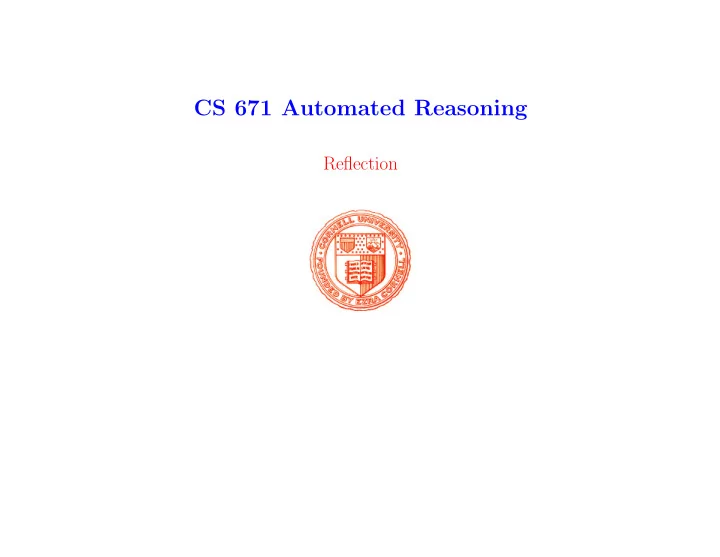

CS 671 Automated Reasoning Reflection
Reflection – basic methodology • Represent object and meta level in type theory – Represent meta-logical concepts as Nuprl terms – Express specific object logic in represented meta logic – Build hierarchy: level i contains meta level for level i +1 Meta level 5 �→ Reasoning about both levels from the “outside” Object level 4 Quotation Meta level 4 Reflection Object level 3 • Link object logic and meta-logic Quotation Reflection Meta level 3 – Embed object level terms using quotation Object level 2 Quotation – Embed object level provability using reflection rule Reflection Meta level 2 Object level 1 Quotation • Use same reasoning apparatus Meta level 1 Reflection Object level 0 for object and meta level CS 671 Automated Reasoning 1 Reflection
Reflection, technically (1) • Represent object level terms ≡ rectype Term = Atom × Parm list × (Var list × Term) list Term x ≡ <<"variable", [ x :v]> []> λx . t ≡ <<"lambda", []> [[ x ], t ]> ( f t ) ≡ <<"apply", []> [[], f ;[], t ]> • Represent meta level operators subst : Term -> Var -> Term -> Term evalto: Term -> Term canonical: Term -> B in: Term -> Term -> P . . . • Represent the proof theory Sequent ≡ (Var × Term)list × Term Proof ≡ Dequent × Rule × Proof list CS 671 Automated Reasoning 2 Reflection
Reflection, technically (2) • Prove semantical relationships . = term Term . ⌈ t ⌉ in ⌈ T ⌉ = t ∈ T . = proof Proof . ⌈ t 1 ⌉ evalto ⌈ t 2 ⌉ = t 1 ↓ t 2 . ∃ p:Proof.goal(p) = ⌈ H ⊢ A ⌉ = H ⊢ A is valid • Add reflection rule H ⊢ i +1 A by reflection i ⊢ i ∃ p:Proof i . goal(p) = ⌈ H ⊢ i +1 A ⌉ • Prove that reflection does not change logic – If a sequent s is provable then it is provable without reflection See “ The Semantics of Reflected Proof ”, (S.Allen, R.Constable, D.Howe, W.Aitken, 1990) CS 671 Automated Reasoning 3 Reflection
Why levels of reflection? Can we use naive reflection ? H ⊢ A by reflection H ⊢ ∃ p:Proof. goal(p) = ⌈⊢ A ⌉ This would enable us to prove ⊢ ¬ ( ∃ p:Proof. goal(p) = ⌈⊢ False ⌉ ) BY notR ∃ p:Proof. goal(p) = ⌈⊢ False ⌉ ⊢ False BY reflection ∃ p:Proof. goal(p) = ⌈⊢ False ⌉ ⊢ ∃ p:Proof. goal(p) = ⌈⊢ False ⌉ BY hypotheses But G¨ odel’s second incompleteness theorem states If a consistent, axiomatizable theory T subsumes arithmetic, then it is impossible to prove the consistency of T within T CS 671 Automated Reasoning 4 Reflection
Why levels of reflection? What if we require all hypotheses to be reflected? H ⊢ A by reflection ⊢ ∃ p:Proof. goal(p) = ⌈ H ⊢ A ⌉ If this rule does not change the logic we should be able to prove ⊢ ( ∃ p:Proof. goal(p) = ⌈ H ⊢ A ⌉ ) ⇒ ( H ⇒ A ) without the reflection rule, which violates G¨ odel’s theorem. Adding a reflection rule leads to a hierarchy of proof levels, which may not be closed off proof theoretically. The reflection rule must include indices to separate the levels. See “ Metaprogramming in Nuprl using Reflection ” (W.Aitken, PHD Thesis 1994) CS 671 Automated Reasoning 5 Reflection
Reflection in practice • Reflection leads to blow-up of term size – Small terms represented by large tuples • Abstractions and display forms can reduce blow-up – Prove laws of reflected concepts and terms – Don’t unfold definitions in formal reasoning – Use colors in displays to separate levels • Substitution and computation remain inefficient – Mechanisms have to be simulated to avoid unfolding terms – Can’t use built-in mechanisms CS 671 Automated Reasoning 6 Reflection
Reflecting terms more efficiently (E. Barzilay) • Change the internal representation of Nuprl terms – Include quotation level as additional parameter of every term – All object levels use the same term syntax . = variable { x :v, 0:Q } () x . = lambda { 0:Q } ( x . t ) λx . t ( f t ) . = apply { 0:Q } ( f ; t ) . x = variable { x :v, 1:Q } () . λx . t = lambda { 1:Q } ( x . t ) ( f t ) . = apply { 1:Q } ( f ; t ) – Some technical subtleties: mixed quotation levels, quoted bindings, . . . • Use built-in substitution and computation • Extend type theory by quotation operator [[ t ]] – Meaning [[ t ]] of t is the obvious term of the next quotation level below [[ opid { p i : F i , j +1:Q } ( subterms ) ]] = opid { p i : F i , j :Q } ( subterms ) – Define operators subst , evalto , canonical , in , . . . using [[ t ]] • Reflection of other concepts almost straightforward CS 671 Automated Reasoning 7 Reflection
Applications • Improving proof automation in theorem proving – Enable proofs by syntactical checks • Formal proof theory – Elegant accounts of G¨ odel’s theorems, . . . • Reasoning about program transformations – Optimizations, aspect weaving • Reasoning about computational complexity – Complexity classes – Resource-bounded logic CS 671 Automated Reasoning 8 Reflection
Recommend
More recommend